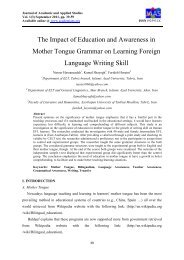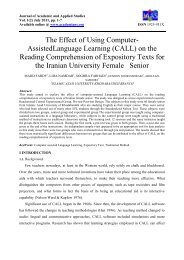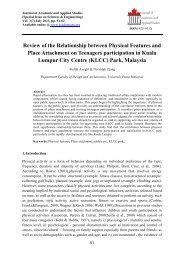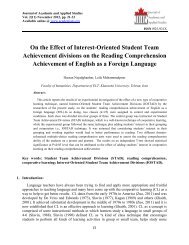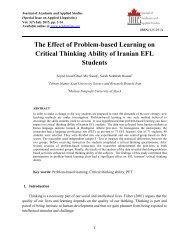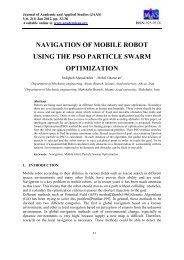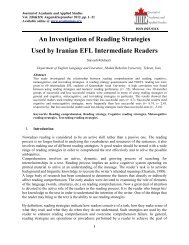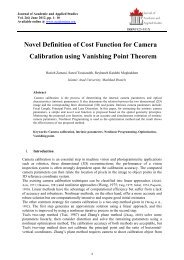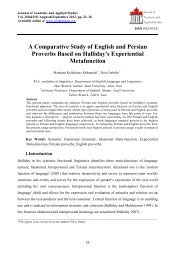<strong>Journal</strong> <strong>of</strong> Academic <strong>and</strong> Applied StudiesVol. 3(3) March 2013, pp. 34-39Available online @ www.academians.orgISSN1925-931XFig.1 The <strong>Franck</strong>-<strong>Hertz</strong> tube <strong>and</strong> electrical connections. K is the cathode , G is the grid <strong>and</strong> A is anodeOn passing through mercury vapor, the electrons collide with the mercury atoms. Thesecollisions may be <strong>of</strong> any one <strong>of</strong> two kinds. One kind is elastic collisions which do not change thevelocity or energy <strong>of</strong> the electrons <strong>and</strong> only change the direction <strong>of</strong> their velocities. The otherkind is inelastic collisions in which the electrons transfer some <strong>of</strong> their energy to the mercuryvapor .Since the electron mass is much lower than the mass <strong>of</strong> a mercury atom electrons hardlylose energy in elastic collisions, ∆E ∝ 4m ebut only change their direction. Therefore them Hgprocesses we are interested in must be caused by inelastic collisions, in which a fraction <strong>of</strong> theelectron energy is converted into internal, in our case excitational energy <strong>of</strong> the atom.Fig.2 If the incoming electron has a kinetic energy which is less than the difference delta E between mercury s n =1<strong>and</strong> n =2 energy levels , then it simply bounces <strong>of</strong>f elastically , keeping all its original kinetic energyElastic collisions between the electrons <strong>and</strong> the mercury atoms cannot prevent the electrons fromreaching the anode. Therefore, they cannot affect the value <strong>of</strong> anode current through the mercury– vapor tube, which is solely controlled by the accelerating field or, rather, by the potentialdifference between the cathode <strong>and</strong> the grid. In constant, during inelastic collisions the electronsmay lose so much <strong>of</strong> their energy that they will not be able to overcome the weak retarding fieldbetween the grid <strong>and</strong> the anode, <strong>and</strong> anode current may drop to practically zero. According to35
<strong>Journal</strong> <strong>of</strong> Academic <strong>and</strong> Applied StudiesVol. 3(3) March 2013, pp. 34-39Available online @ www.academians.orgISSN1925-931XBohrs first postulate, the amount <strong>of</strong> energy that a mercury atom can receive from a collidingelectron is just sufficient for the atom to undergo a transition to one <strong>of</strong> excited states. The excitedstate nearest to the ground or normal state for a mercury atom is separated by an energy gap <strong>of</strong>4.88 ev.Fig.3 If the electron has kinetic energy equal to delta E , then it transfers most <strong>of</strong> its kinetic energy to the mercuryatom , boosting the atom to the n=2 state . That levels the electron with very little kinetic energyUntil the electrons accelerated by the field acquire an energy <strong>of</strong> ev 1 = 4.86e, they experience onlyelastic collisions in which they lose no energy <strong>and</strong> reach the anode so that anode current is rising.As soon as an electron gains an energy <strong>of</strong> 4.86 ev an inelastic collision may take place, theelectron may transfer all <strong>of</strong> its energy to a mercury atom, <strong>and</strong> this may jump from the groundinto the excited state . Obviously, the electron cannot now overcome the weak retarding fieldbetween t grid <strong>and</strong> the anode <strong>and</strong> will fail to reach the anode. Thus at a potential difference <strong>of</strong>4.86 V between the cathode <strong>and</strong> the grid , anode current should show a sudden decrease . Similarevents should happen when the potential difference is 2×4.86V, 3x4.86v, etc. that is, whenelectrons may experience two , three or more inelastic collisions. This relation between anodecurrent <strong>and</strong> the difference in potential, V 1 , between cathode <strong>and</strong> grid in the <strong>Franck</strong>-hertzexperiment is shown in the plot <strong>of</strong> fig .2 . As is seen , anode current suddenly decreases at V 1equal to 4.86 V , 9.72 V <strong>and</strong> 14.58 V , in accordance with Bohr s first postulate .[1]The <strong>Franck</strong> –<strong>Hertz</strong> experiments came as a pro<strong>of</strong> <strong>of</strong> Bohr s third postulate in the following way.The mercury vapor in the tube was noted to emit ultraviolet light at a wavelength <strong>of</strong> 2537 A.This emission is explained by the fact that the mercury atoms excited by their collisions withelectrons can reside in an excited state for a very short time interval, about 10 -8s ,<strong>and</strong> then jumpback to their ground or normal state . According to Bohr S Third postulate, each transition <strong>of</strong> anatom to its ground state is accompanied by the emission <strong>of</strong> a quantum <strong>of</strong> radiant energy , or aphoton <strong>of</strong> magnitude ∆E = hθ .From ∆E = 4.86eV ,where e=1.6×10 -19 c is the electronic charge , the wavelength <strong>of</strong> emittedlight is found to be λ = c θ = hc∆E = 2537A°36



